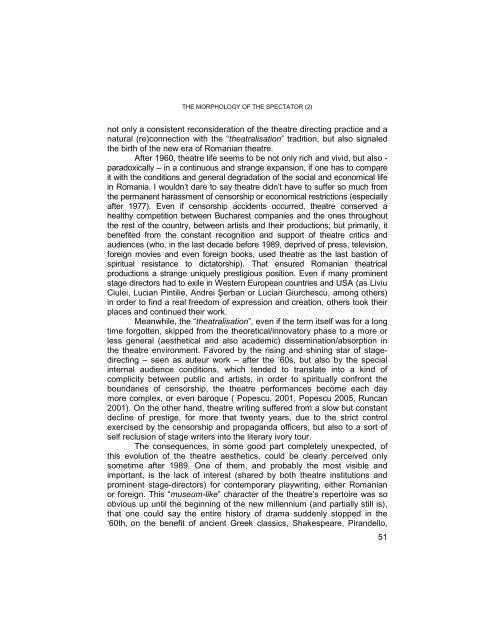studia universitatis babeÅ â bolyai dramatica teatru, film, media 2
studia universitatis babeÅ â bolyai dramatica teatru, film, media 2
studia universitatis babeÅ â bolyai dramatica teatru, film, media 2
Create successful ePaper yourself
Turn your PDF publications into a flip-book with our unique Google optimized e-Paper software.
THE MORPHOLOGY OF THE SPECTATOR (2)<br />
not only a consistent reconsideration of the theatre directing practice and a<br />
natural (re)connection with the “theatralisation” tradition, but also signaled<br />
the birth of the new era of Romanian theatre.<br />
After 1960, theatre life seems to be not only rich and vivid, but also -<br />
paradoxically – in a continuous and strange expansion, if one has to compare<br />
it with the conditions and general degradation of the social and economical life<br />
in Romania. I wouldn’t dare to say theatre didn’t have to suffer so much from<br />
the permanent harassment of censorship or economical restrictions (especially<br />
after 1977). Even if censorship accidents occurred, theatre conserved a<br />
healthy competition between Bucharest companies and the ones throughout<br />
the rest of the country, between artists and their productions; but primarily, it<br />
benefited from the constant recognition and support of theatre critics and<br />
audiences (who, in the last decade before 1989, deprived of press, television,<br />
foreign movies and even foreign books, used theatre as the last bastion of<br />
spiritual resistance to dictatorship). That ensured Romanian theatrical<br />
productions a strange uniquely prestigious position. Even if many prominent<br />
stage directors had to exile in Western European countries and USA (as Liviu<br />
Ciulei, Lucian Pintilie, Andrei Şerban or Lucian Giurchescu, among others)<br />
in order to find a real freedom of expression and creation, others took their<br />
places and continued their work.<br />
Meanwhile, the “theatralisation”, even if the term itself was for a long<br />
time forgotten, skipped from the theoretical/innovatory phase to a more or<br />
less general (aesthetical and also academic) dissemination/absorption in<br />
the theatre environment. Favored by the rising and shining star of stagedirecting<br />
– seen as auteur work – after the ’60s, but also by the special<br />
internal audience conditions, which tended to translate into a kind of<br />
complicity between public and artists, in order to spiritually confront the<br />
boundaries of censorship, the theatre performances become each day<br />
more complex, or even baroque ( Popescu, 2001, Popescu 2005, Runcan<br />
2001). On the other hand, theatre writing suffered from a slow but constant<br />
decline of prestige, for more that twenty years, due to the strict control<br />
exercised by the censorship and propaganda officers, but also to a sort of<br />
self reclusion of stage writers into the literary ivory tour.<br />
The consequences, in some good part completely unexpected, of<br />
this evolution of the theatre aesthetics, could be clearly perceived only<br />
sometime after 1989. One of them, and probably the most visible and<br />
important, is the lack of interest (shared by both theatre institutions and<br />
prominent stage-directors) for contemporary playwriting, either Romanian<br />
or foreign. This “museum-like” character of the theatre’s repertoire was so<br />
obvious up until the beginning of the new millennium (and partially still is),<br />
that one could say the entire history of drama suddenly stopped in the<br />
‘60th, on the benefit of ancient Greek classics, Shakespeare, Pirandello,<br />
51

















